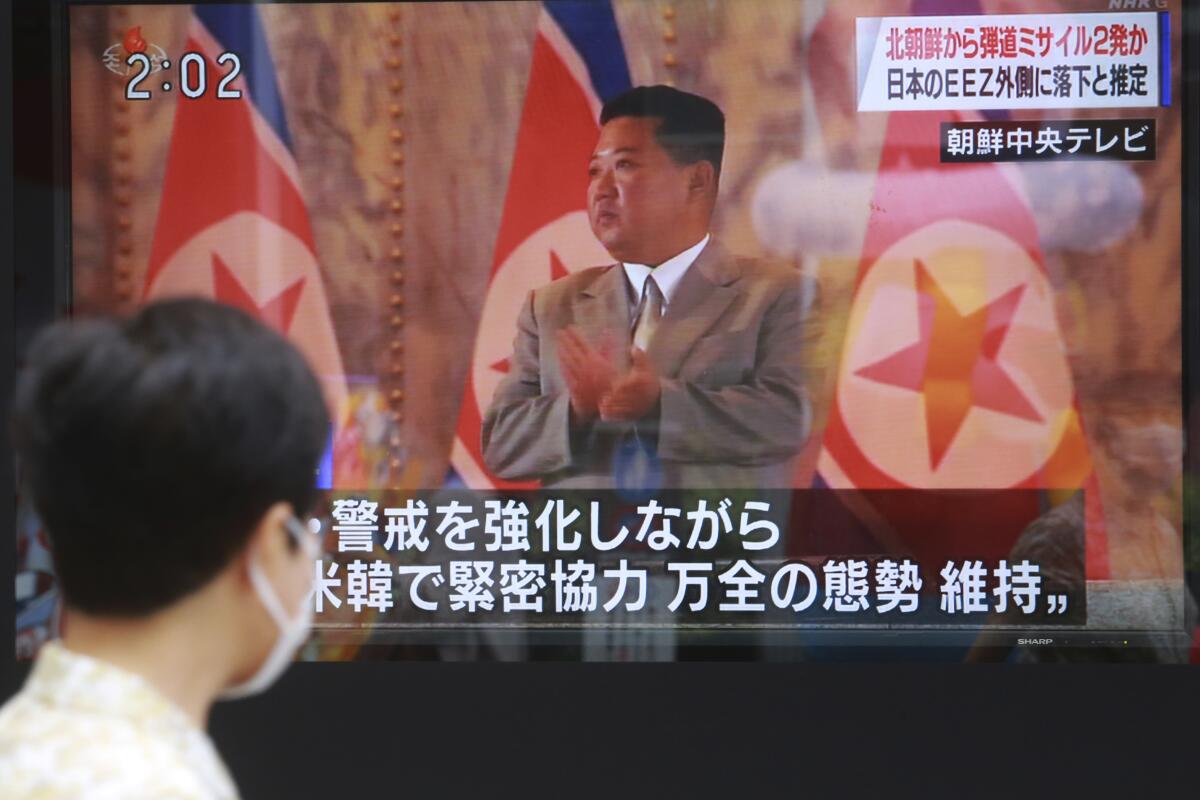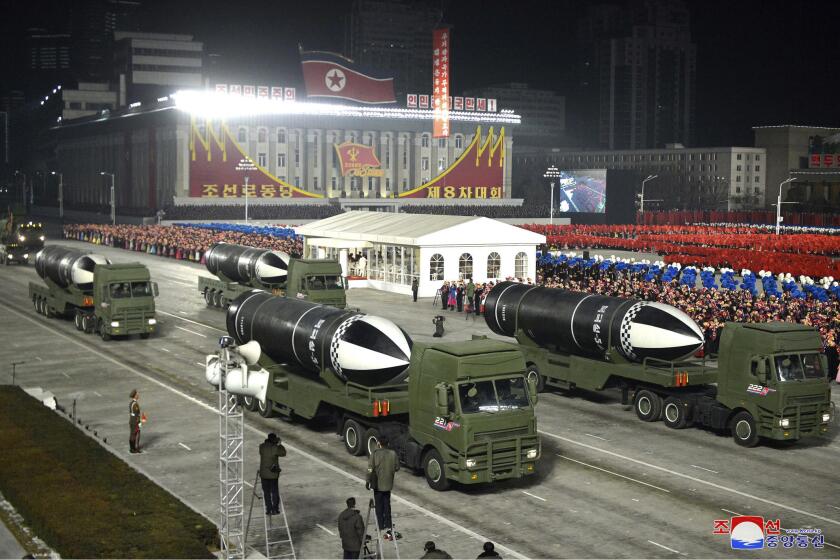Kim Jong Un’s sister warns of ‘destruction’ of South Korea ties after rival missile tests

SEOUL — The powerful sister of North Korean leader Kim Jong Un on Wednesday criticized South Korea’s president and threatened a “complete destruction” of bilateral relations after the two countries tested ballistic missiles hours apart.
The missile launches underscored a return of tensions between the rival Koreas at a time when talks aimed at halting North Korea’s nuclear program are stalled.
Kim’s sister, Kim Yo Jong, criticized South Korean President Moon Jae-in for comments he made while observing his country’s missile tests, including its first of a submarine-launched ballistic missile. Moon said South Korea’s growing missile capabilities would serve as a “sure deterrence” against North Korean provocations.
South Korea’s tests came hours after the South Korean and Japanese militaries said the North had fired two ballistic missiles into the sea.
In a statement carried by state media, Kim Yo Jong berated Moon for describing North Korean weapons demonstrations as a provocation, and warned of a “complete destruction” of bilateral relations if he continued with what she described as slander of North Korea.
She said that North Korea was developing its military capabilities for self-defense without targeting a specific country, and that South Korea was also increasing its military capabilities. Pyongyang has often accused Seoul of hypocrisy for introducing modern weapons while calling for talks on easing tensions between the two sides.
North Korea’s new missiles tests renew concerns that the country is building its capacity to deliver strikes on U.S. allies South Korea and Japan.
“If the president joins in the slander and detraction [against us], this will be followed by counteractions, and the North-South relations will be pushed toward a complete destruction,” she said. “We do not want that.”
The South Korean and Japanese militaries said North Korea fired two short-range ballistic missiles that flew 500 miles before landing in the sea within Japan’s exclusive economic zone — a worrying development even though they did not reach Japan’s territorial waters. The last time a North Korean missile landed inside that zone was October 2019.
The launches came two days after the North said it fired a newly developed long-range cruise missile, its first weapons test in six months.
Hours after the North Korean launches Wednesday, South Korea reported its first test of a submarine-launched ballistic missile. As Moon and other top officials looked on, the missile flew from a submarine and hit a designated target, the president’s office said. It did not say how far the weapon flew.
North Korea has displayed new submarine-launched ballistic missiles under development and other military hardware in a massive nighttime parade.
Experts say the North Korean launches are an effort to apply pressure on the United States in the hopes of winning relief from sanctions aimed at persuading the North to abandon its nuclear arsenal. U.S.-led talks on the issue have been stalled for more than two years — and in the meantime, tensions have been rising on the Korean peninsula.
“North Korea is trying to communicate a message that things will not go as Washington wishes if it doesn’t accept the North’s demands,” said Moon Seong-mook, an analyst with the Seoul-based Korea Research Institute for National Strategy. He said Pyongyang may think it has an opportunity now to win concessions from the U.S. while the Biden administration is embroiled in a domestic debate after the chaotic pullout from Afghanistan.
Meanwhile, observers say President Moon’s government, which has been pursuing reconciliation with North Korea, may be responding to criticism that it is too soft on the North.
The rival nations are still technically in a state of war. The 1950-53 Korean War, which pitted the North and ally China against the South and U.S.-led United Nations forces, ended in an armistice, not a peace treaty.
Start your day right
Sign up for Essential California for the L.A. Times biggest news, features and recommendations in your inbox six days a week.
You may occasionally receive promotional content from the Los Angeles Times.
Japanese Prime Minister Yoshihide Suga said the North Korean launches “threaten the peace and safety of Japan and the region and are absolutely outrageous.”
The U.S. Indo-Pacific Command said the move “highlights the destabilizing impact of [North Korea’s] illicit weapons program,” though it added that the test missiles didn’t pose an immediate threat to the U.S.
The launches were a violation of U.N. Security Council resolutions that bar North Korea from engaging in any ballistic missile activities. But the Security Council typically doesn’t slap fresh sanctions on North Korea when it launches short-range missiles, like the ones fired Wednesday.
The North Korean launches came as Chinese Foreign Minister Wang Yi was in Seoul for meetings with President Moon and other senior South Korean officials to discuss the stalled nuclear negotiations with North Korea.
U.N. human rights investigators have asked North Korea to clarify whether it has ordered troops to shoot on sight any trespassers who cross its northern border in violation of the country’s pandemic closure.
It’s unusual for North Korea to make provocative launches when China, its last major ally and biggest aid provider, is engaged in a major diplomatic event. But some experts say North Korea may have used the timing to draw extra attention.
Kim Dong-yub, a professor at the University of North Korean Studies in Seoul, said Wednesday’s tests appeared to be of an improved version of a short-range missile Pyongyang tested in March. He said the weapon is probably modeled on Russia’s Iskander missile, whose flattened-out low-altitude flight makes it hard to intercept.
The international community is intent on getting the North to abandon its nuclear program and has long used a combination of the threat of sanctions and the promise of economic help to try to influence Pyongyang. But nuclear talks between the U.S. and North Korea have stalled since 2019, when the Trump administration rejected the North’s demand for major sanctions relief in exchange for dismantling an aging nuclear facility.
Kim Jong Un’s government has so far rejected the Biden administration’s overtures for dialogue, demanding that Washington abandon what it calls “hostile” policies first. But the North has maintained its self-imposed moratorium on nuclear and long-range missile tests, a sign that it may not want to completely scuttle the possibility of reopening the talks.
North Korean leader Kim Jong Un berates top officials for coronavirus-prevention failures that have caused an unspecified ‘great crisis.’
In 2017, North Korea claimed to have acquired the ability to strike the U.S. mainland with nuclear weapons after conducting three intercontinental ballistic missile tests and its most powerful nuclear test. In recent years, it’s also performed a series of underwater-launched missile tests in what experts say is a worrying development because such weapons are difficult to detect in advance and would provide the North with a second, retaliatory strike capability.
South Korea, which doesn’t have nuclear weapons, is under the protection of the U.S. “nuclear umbrella,” which guarantees a devastating American response in the event of an attack on its ally. But South Korea has been accelerating efforts to build up its conventional arms, including developing more powerful missiles.
Experts say the South’s military advancements are aimed at improving its capacity for preemptive strikes and destroying key North Korean facilities and bunkers.
Separate from the submarine-launched missile, South Korea also tested a missile from an aircraft that is in development.
More to Read
Sign up for Essential California
The most important California stories and recommendations in your inbox every morning.
You may occasionally receive promotional content from the Los Angeles Times.














